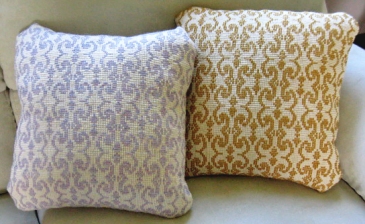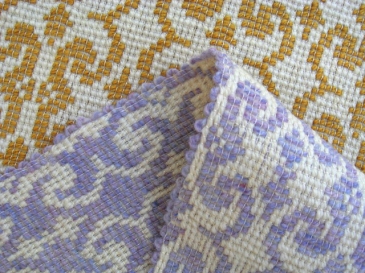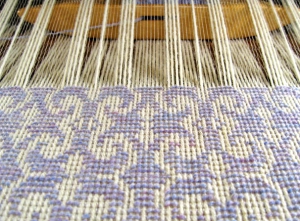My latest weaving projects – pillows and scarves – are very different in their appearance and function, but they share a common weave structure, a variation of Diversified Plain Weave (DPW).
In my research, I found an early reference to DPW in G. H. Oelsner’s, A Handbook of Weaves (downloadable at handweaving.net), first published in 1915. Oelsner describes diversified weaves as patterns that “can be obtained by adding or removing risers from a ground weave,” and calls them “diversified plain weaves” when the ground is a plain weave. In later books and articles there are references to Klara Cherpov’s 1972 monograph, “Diversified Plain Weave,” that seems to be a definitive study on the subject. DPW is sometimes described as a weave structure where one color of heavy warps and another color of heavy wefts form a pattern and are tied down by fine warps and wefts that form plain weave. The woven cloth is two-sided with the reverse pattern showing on the back. There are no long floats, the surface is tightly interlocked so it’s great for such uses as upholstery fabric.
I then came across Madelyn van der Hoogt’s article, “Thick ‘N Thin Again” in Weaver’s magazine #36 (Summer ’97) where she describes a new variation of DPW that I decided to use for the pillows and scarves. This new DPW is more appealing to me than the original DPW because it seems easier to follow and in some cases allows for more blocks with fewer shafts. Some weavers prefer the original DPW because they say they like the surface structure of the woven cloth better. For more information about DPW, Judy (Fibres of Being) has some great drafts and detailed notes about it. Madelyn van der Hoogt’s book, The Best of Weaver’s: Thick ‘N Thin, is a compilation of many articles about it that were first published in various issues of Weaver’s magazine.
Below are images of the pillows and scarves with drafts and notes on how I designed and wove them.
Diversified Plain Weave (variation) Wool & Pearl Cotton Pillows
When it comes to block weaves, I sometimes like to design a pattern in the tie-up rather than start with a profile draft. About two years ago I designed a Summer & Winter table runner this way. Experimenting with different swirly patterns in the tie-up, it was great fun watching the pattern evolve until I liked it enough to use for the pillows. Note the thick and thin warps and wefts in the draft and how they interlace to create this weave that looks a little bit like needlepoint in the woven cloth. Erica de Ruiter’s article in Weaver’s #44 (Summer ’99), “Petit Point Scarves,” shows a beautiful scarf with an intricate pattern woven on only 3 shafts that is also similar to the newer variation of DPW in a free-form pick-up technique.
I wove the fabric for the pillows using a tightly twisted 4-ply worsted type wool as the thick warp and weft (except the lavender pillow weft, I think, is a 2-ply woolen type) and 20/2 pearl cotton as the thin warp and weft. I wove a few small samples first with different setts and finishings and ended up using 24 e.p.i., 3 per dent in an 8-dent reed, 2 thin and 1 thick per dent, with almost the same p.p.i. Using 2 warp beams, one for the wool warp and the other for the cotton, helped eliminate any potential tension problems. I know that wet finishing is best for wool in most cases but since these are decorative pillows I chose to only steam iron the back side of the fabric. This preserved the loftiness of the wool in the front and at the same time softened the stiffness that the cloth had when it came off the loom.
Since I weave on a 16-shaft treadle loom, it would have been difficult for me to weave the pattern the way you see it on the draft because many shafts tied to one treadle can be very heavy to lift without some kind of lift assist. So for easier lifting, I rearranged the treadles (divided the 14 shafts tied to one treadle to two treadles, placed them in the center and pressed with both feet) and reversed the other tie-ups so the back side of the pattern was facing up as I wove.
Diversified Plain Weave (variation) Chenille/Rayon/Cotton Scarves
After having some success weaving a shadow weave chenille scarf some time ago, I thought I’d try chenille again but together with other fibers. I wove a series of scarves using rayon chenille (1450 yds./lb.) as the thick warp, rayon bouclé as the thick weft, and 20/2 cotton as the thin warp and weft. The sett is the same as for the pillows, 24 e.p.i., but the p.p.i. is a bit closer at about 28. The possible color combinations are endless and by changing the color of the thin warp and/or weft the saturation (intensity) and value (light/dark) of the heavy warp/weft colors may be altered in subtle ways. The draft for the scarves shows only one possible color scheme and doesn’t represent the actual number of repeats I used.
As the weaving progressed, the chenille became slack while the cotton remained tight, so winding the chenille separately on a second warp beam was very helpful to correct this. If you don’t have a double warp beam, on a short warp you can insert a rod and suspend it with weights so the chenille warp is weighted down enough to even out the tension.
To finish the scarves, they were first washed with a little detergent and rinsed on the gentle cycle in the washer, agitated for only half a minute, spin dried carefully (you can roll them in a towel instead), and laid flat to dry. Instead of placing them in the dryer as I usually would with chenille, I steam ironed them because the rayon looks beautiful this way and the chenille, even though it’s flattened, has a sheen to it. Also, instead of fringes, I hand sewed hems on these scarves.
♥♥♥♥♥♥♥♥♥♥♥♥♥♥♥♥♥♥♥♥♥♥♥♥♥♥♥♥♥♥♥♥♥♥
I’m sorry to share some sad news, my weaver friend, Fern (also known as “buyathread”), passed away on September 14 after a long illness…
In Memory of
Fern Devlin
1942-2011
Friend, fellow weaver and blogger, renowned scarf designer, and a truly nice person. Fern, you will be missed and never forgotten.
♥♥♥♥♥♥♥♥♥♥♥♥♥♥♥♥♥♥♥♥♥♥♥♥♥♥♥♥♥♥♥♥♥♥






